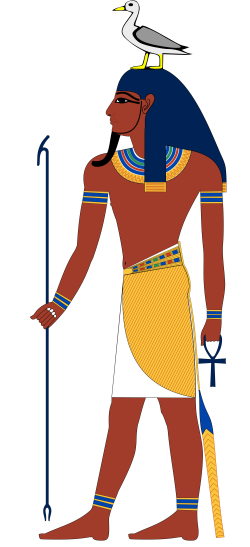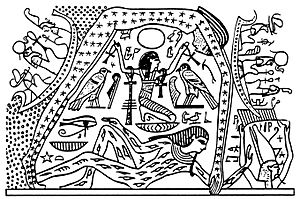Geb facts for kids
Quick facts for kids Geb |
|
|---|---|
| God of the Earth and the Harvest | |
 |
|
| Symbol | barley, goose, bull, viper |
| Personal information | |
| Consort | Nut, Tefnut, Renenutet (some sources) |
| Offspring | Osiris, Isis, Set, Nephthys, Heru-ur, Nehebkau (some sources) |
| Parents | Shu and Tefnut |
| Siblings | Nut |
| Greek equivalent | Cronus |
Geb was the ancient Egyptian god of the Earth, one of the nine principal gods who created the world. He was the husband of Nut (the sky goddess), the father of Osiris, Seth, Isis, and Nephthys. Geb's parents were Shu, the god of air, and Tefnut, the goddess of moisture.
The ancient Egyptians had fascinating beliefs about him. They thought that when Geb laughed, it caused earthquakes! They also believed he was the reason crops could grow from the ground, providing food for everyone.
Other names for Geb included Seb, Keb, Kebb, Qeb, and Sebb. Sometimes, people compared Geb to the Greek Titan Kronos.
Contents
Geb's Family and the World
Ancient Egyptian myths tell us about Geb and his sister, Nut. They were born holding onto each other very tightly. Their father, Shu, who was the god of air, had to separate them. This story explains why the earth and the sky are apart.
Geb and Nut later married. From their union, the sun was born. They also had five important children: Osiris, Isis, Nephthys, Horus, and Seth. These children became very important gods and goddesses in Egyptian mythology.
What Geb Looked Like
Geb was often shown as a man. He sometimes wore the crown of North Egypt or the crown of South Egypt. Other times, he wore a white crown. A goose was also a common symbol for Geb. He sometimes wore a goose on his head, or his head was even shown as a goose's head.
In his hands, Geb usually held a staff. In his right hand, he often held an Ankh, which was an ancient Egyptian symbol for life. Geb's skin was sometimes green, representing the Nile River and its plants. It could also be black, showing the rich, fertile soil.
Why Egyptians Worshipped Geb
People mainly worshipped Geb during harvest times. Egyptians believed he helped their crops grow from the earth. He was also important for the journey of the soul after death. Because of this, Egyptians also worshipped him during times of sadness and mourning.
The city of Heliopolis was a main center for worshipping Geb.
Roles
Father of Snakes
One of Geb's titles was "father of snakes." In ancient Egypt, snakes were both feared and respected, often seen as creatures connected to the earth and the underworld. The Egyptian word for snake literally meant "son of the earth," highlighting this deep connection.
Divine King and Judge
Beyond being the Earth itself, Geb was also considered a divine king. Ancient Egyptian mythology tells us that he was one of the earliest rulers of Egypt, a time when gods walked among humans. After his reign, he passed the throne to his son, Osiris, and then to his grandson, Horus, after many legendary conflicts with Osiris's disruptive brother, Set. This lineage established Geb as a foundational figure in the divine royal succession of Egypt.
Later, after his time as king, Geb took on the important role of a judge in the Divine Tribunal of the gods. This meant he had a hand in deciding matters of justice and fate among the deities.
The Underworld
Geb also played a role in the journey of the deceased. He was metaphorically described as "Geb opening his jaws" to either release the dead from their tombs or to imprison those not worthy of reaching the heavenly Field of Reeds, a paradise in the afterlife.
Representations
The oldest known representation of Geb dates back to the reign of King Djoser during the Third Dynasty (around 2686–2613 BCE).
His most common and recognizable depiction was as a reclining man, often with green patches or plants growing on his skin, symbolizing the vegetation that springs from the Earth.
Interesting facts about Geb
- Geb's name might mean "weak one" or "lame one."
- Ancient Egyptians believed that earthquakes were caused by Geb's laughter. This is why he was sometimes called the Great Cackler.
- The main animals linked to Geb are the snake and the goose. A goose is often seen on his head.
- He was often painted with green skin or with plants on his body to show his connection to living things.
- Geb was sometimes shown in the form of a ram, a bull, or a crocodile.
- Interestingly, despite his importance, Geb never had a temple dedicated solely to him, unlike many other major gods.
See also
 In Spanish: Geb para niños
In Spanish: Geb para niños


